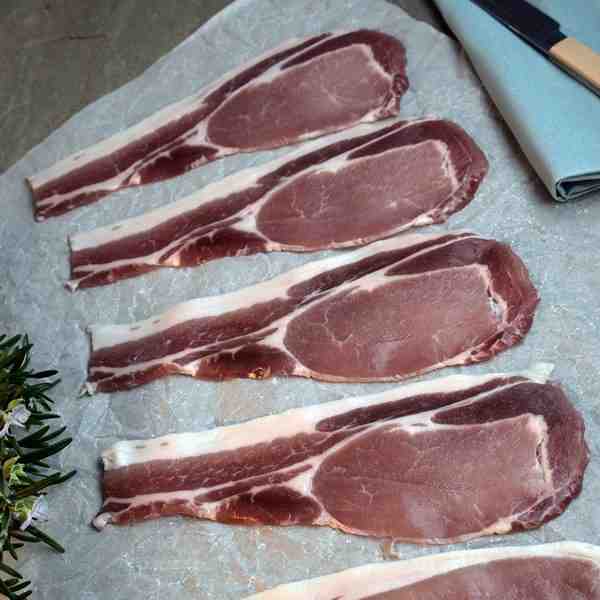Is there any ham that is not processed?

So what is undried ham? Simply put, undried ham is ham that is subjected to a much more natural drying process. Read also : How many types of ham are there?. The main difference between undried and dried ham is the use of synthetically derived nitrates, which can be converted into carcinogenic chemicals.
Which parts of the meat are not processed? In addition to cold cuts, there are other processed meat bacon, salami, bologna, hot dogs and sausages. Fresh chicken, turkey, beef, pork and fish that have not been modified are considered unprocessed meat.
What is the healthiest ham to buy?
The healthiest are their all-natural undried ham and all-natural apple ham, which are preservative-free and made without nitrates or nitrites. On the same subject : Why is ham called gammon?. They contain only 70 calories, 2 grams of fat and 440 milligrams of sodium per serving.
Is sliced ham healthy?
Meat for lunch, including cold cuts, bologna and ham, is on the list of unhealthy because it contains a lot of sodium and sometimes fat and some preservatives such as nitrites.
What is the safest ham to eat?
Unpackaged cooked ham is potentially contaminated with pathogens. For cooked hams that have been repackaged at any other location outside the processing plant, or for leftover cooked ham, heat to 165 ° F. Spiral-cut cooked hams are also safe to eat cold.
Is all ham considered processed meat?
ja “Processed meat” means any meat preserved by salting, smoking or drying or by the addition of chemical preservatives. This means sausages, bacon, cold cuts such as pastrami and salami, hot dogs and, yes, ham.
Does ham count as processed meat?
Processed meat is smoked, salted, smoked or fermented meat and includes ham, devon, bacon, salami, frankfurt, prosciutto and some sausages such as cabanossi and kransky. We recommend limiting or avoiding processed meats because of their association with an increased risk of bowel and stomach cancer.
Is all ham considered processed?
Conclusion: All meat that has been smoked, salted, smoked, dried or canned is considered processed. This includes sausages, hot dogs, salami, ham and bacon.
Is all ham considered processed?
Conclusion: All meat that has been smoked, salted, smoked, dried or canned is considered processed. This includes sausages, hot dogs, salami, ham and bacon.
Is ham a processed food?
What is processed meat? Processed meat is smoked, salted, smoked or fermented meat and includes ham, devon, bacon, salami, frankfurt, prosciutto and some sausages such as cabanossi and kransky.
What meats are not processed food?
Organically caught seafood is another unprocessed food that you should include in your diet as it is rich in protein and omega-3 fatty acids. Chicken, beef and pork are excellent sources of protein and iron. Avoid delicacies, hot dogs and bacon that are highly processed.
What is gammon in the UK?

Gammon is a pejorative that has been popularized in British political culture since about 2012. The term refers particularly to the color of a person’s red faces when expressing their firm opinion, compared to the pork type of the same name.
Is Pork Gammon? Gammon and ham are absolutely delicious pork that are incredibly versatile and can be enjoyed in many recipes – no wonder we have been eating gammon and ham for millennia!
What is Gammon called in English?
The word ‘gammon’ comes from the Middle English word for ‘ham’, gambon, which dates back to the early 15th century and comes from the old northern French word gambon, which itself derives from the Old French word jambon, which is identical to the modern French word. for ‘ham’.
What’s the difference between pork and ham?

Pork is a piece of meat from a domesticated pig in its raw form, and ham is a specific piece of pork from a pig’s hind legs.
What is healthier pork or ham? Pork is richer in most vitamins, phosphorus, magnesium and potassium. It is cheaper, associated with greater health disadvantages than benefits. On the other hand, ham is a derivative of pork that contains less protein and fat, especially cholesterol, trans fats and saturated fats, but a higher sodium content.
Why is ham pink and pork white?
But what is the same with both methods is the presence of sodium nitrite (or less commonly sodium nitrate). It inhibits the growth of bacteria (an extremely dangerous species that can cause botulism), which ensures that the meat is safe to eat, and also causes the meat to retain its pink color, similar to when raw.
Why is ham different than pork?
The main difference between ham and pork stems from the fact that all ham is pork, but not all pork is ham. Ham is a special piece of pork from pork thighs. It is usually dried and salted. Ham is available in ready form.
Are ham and pork the same thing?
Ham is cut pork that has been preserved by wet or dry drying, with or without smoking. As processed meat, the term “ham” includes both whole pieces of meat and those that have been mechanically shaped.
Why is ham so different?
When sold raw, the pork has a pale pink color that can be slightly darker depending on which piece it is. Lean meats such as chops and slices are usually lighter in color, while fatty cuts such as pork leg are usually darker. The drying process gives the ham its characteristic flavor and deep pink hue.
How does pork become ham?
Ham is cut pork that has been preserved by wet or dry drying, with or without smoking. As processed meat, the term “ham” includes both whole pieces of meat and those that have been mechanically shaped.
Where does ham come from on a pig?
Another common piece of pork comes from the thigh – ham. Foods usually have a wide range of ham products available – from whole hams to hams cut for gourmet meat. It all comes from a pig’s foot. Ham is often dried, cut or processed before purchase.
What cut of pork makes ham?
Ham is traditionally made from pork leg or pork shoulder. For starters, we recommend that you first try to make a ‘picnic’ ham from the shoulder. The meat tastes quite similar, but the process is a little faster and easier for the first time.
Is gammon thick bacon?

First, gammon is usually thicker than bacon and also more expensive. Some people prefer gammon to bacon, not only because it is thicker, but also because it can be served with a greater variety of dishes. Both bacon and gammon can be wet or dry and can be smoked freely.
What is the difference between ham and ham? Both of these delicious and versatile pieces are taken from the pig’s hind legs. Gammon is meat that has been dried (by salting, salting, or smoking) and sold raw, while ham is meat that has been dried or cooked and sold ready to eat. Briefly; when you cook your Gammon, it becomes Ham.
What is the difference between bacon and gammon?
Bacon is a piece of dried pork made with any piece of meat, unlike gamona. It is true that gammon is the last leg cut from the side of the bacon after hardening and traditionally the fuel should be the mildest, but we are in the habit of calling every piece of bacon suitable for cooking and baking a piece of ham.
What is the difference between gammon ham and bacon?
Glorious Gammon This is dried pork from the hind legs of a pig. The drying process is the same as that used for bacon, a highly skilled method of preserving meat with salt (either in brine solution or dry dried with salt-based fat). Dry drying gives a softer taste and improved meat texture.
What is the difference between gammon and pork?
Gammon is the last pork leg after it has been dried with dry salting or brine, which may or may not be smoky. Strictly speaking, gammon is the lower part of the whole side of the bacon (which includes the back leg), ham is just the back leg that dries.
Can I use gammon instead of bacon?
Either way, these are usually dry dry. Gammon pieces come from the hind legs of a pig. It is usually wet hardened. Update: According to your pictures above, yes, gammon can be used as a substitute for the last bacon.
Can ham be used as bacon?
| bacon | Ham | |
|---|---|---|
| Description | Dried meat prepared from pigs. | Meat of the thigh or buttocks of a pig, cut from the thigh of a pig or boar. |
Can you substitute gammon for bacon?
Update: According to your pictures above, yes, gammon can be used as a substitute for the last bacon.
Is gammon steak a bacon?
Strictly speaking, gammon is the bottom of the whole side of the bacon (which includes the back leg), ham is just the back leg that dries. Just like bacon, it must be cooked before it can be eaten; in this sense, gamona is comparable to fresh pork and differs from dried ham such as prosciutto.
Is gammon steak the same as bacon?
Gammon and bacon are dried pork. The main difference between them is the part of the pig from which they originate. Gammon is the hind leg of a pig, and bacon is meat from other parts of the pig, such as the back, collar or belly.
What meat is gammon steak?
Gammon steak is gammon steak from the last quarter of a pig that is dried by dry salting, salting or smoking. It is delicious in combination with pineapple and egg or potatoes and vegetables or is included in carbonara pasta and other dishes.
Is gammon a bacon or ham?

Bacon could not be called pork slices because it was dried, salted or smoked. The same goes for ham that is already cooked. Gammon is just uncooked ham. It’s about where the meat was and not where it came from.
Is ham and bacon the same thing? Overview. Bacon is meat taken from the back, back or belly of a pig. The bacon is either dried in cold air or by smoking or packed with large amounts of salt or dried wet when immersed in liquid brine. Ham is meat cut from the thigh or thigh of a pig.
Is gammon the same as ham?
Gammon is meat that has been dried (by salting, salting, or smoking) and sold raw, while ham is meat that has been dried or cooked and sold ready to eat. Briefly; when you cook your Gammon, it becomes Ham.
Why is ham called gammon?
The word ‘gammon’ comes from the Middle English word for ‘ham’, gambon, which dates back to the early 15th century and comes from the old northern French word gambon, which itself derives from the Old French word jambon, which is identical to the modern French word. for ‘ham’.
Is gammon classed as ham?
Gammon is sold in supermarkets and your local butcher raw and requires cooking before you can eat it, while the ham is ready to eat right away, but both are made in a very similar way. Both savage and ham are cut from the hind legs of the pig and are salted, salted or smoked.
Is gammon like bacon?
Bacon is a piece of dried pork made with any piece of meat, unlike gamona. It is true that gammon is the last leg cut from the side of the bacon after hardening and traditionally the fuel should be the mildest, but we are in the habit of calling every piece of bacon suitable for cooking and baking a piece of ham.
Can I use gammon instead of bacon?
Either way, these are usually dry dry. Gammon pieces come from the hind legs of a pig. It is usually wet hardened. Update: According to your pictures above, yes, gammon can be used as a substitute for the last bacon.
What is the difference between gammon ham and bacon?
Glorious Gammon This is dried pork from the hind legs of a pig. The drying process is the same as that used for bacon, a highly skilled method of preserving meat with salt (either in brine solution or dry dried with salt-based fat). Dry drying gives a softer taste and improved meat texture.
Why did my bacon turned GREY when cooked?
If not treated with sodium nitrate, red meat, depending on the animal it comes from, turns white or gray after cooking. This is true for pork as well as for beef, lamb and veal. Unless it was cooked at a high enough temperature to brown the surface.
Is bacon okay if it turns gray? When spoiled, the characteristic red hue of your bacon can become dull and fade to gray, brown, or greenish. Pampered bacon can also be slimy or sticky, but not soft and moist. Bacon that has a sour or rotten odor should also be discarded as this is another sign of spoilage.
How do you tell if cooked bacon is spoiled?
Four signs that the bacon is spoiled
- It doesn’t smell right. Bacon must not have a strong odor. …
- It feels slimy. Fresh bacon should be soft and slightly moist. …
- It’s discolored. Fresh bacon should have tempting strips of white fat marbled with pinkish red flesh. …
- It’s Moldy.
What happens if you eat cooked spoiled bacon?
If you eat spoiled bacon, you may experience symptoms such as nausea, vomiting, diarrhea, fever, chest pain, and dehydration, which can eventually lead to hospitalization. Pork food poisoning can occur quickly or it takes weeks for it to occur.
Is discolored bacon safe to eat?
Bacon is safe to eat if it still has a natural pink color, with the fat being white or yellow. If the bacon has turned brown or gray with a hint of green or blue, then it has gone off.
Is discolored bacon still good?
Your bacon is still safe if it still has its natural pink color, with the fat being white or yellow. If your bacon has turned brown or gray with a hint of green or blue, it has already spoiled.
What happens if you eat bad bacon?
If you eat spoiled bacon, you may experience symptoms such as nausea, vomiting, diarrhea, fever, chest pain, and dehydration, which can eventually lead to hospitalization. Pork food poisoning can occur quickly or it takes weeks for it to occur.
Why is my cooked bacon grey?
If your bacon has turned brown or gray with a hint of green or blue, it has already spoiled. Too much exposure to air causes a chemical reaction on the meat that leads to discoloration.
How do I know if cooked bacon is bad?
How to determine if cooked bacon is bad or spoiled? The best way is to smell and look at the bacon: signs of bad bacon are a sour smell and a slimy texture; discard bacon that has an unpleasant odor or appearance, don’t try it before.
Is it safe to eat grey bacon?
Your bacon is still safe if it still has its natural pink color, with the fat being white or yellow. If your bacon has turned brown or gray with a hint of green or blue, it has already spoiled. Too much exposure to air causes a chemical reaction on the meat that leads to discoloration.
Sources :
